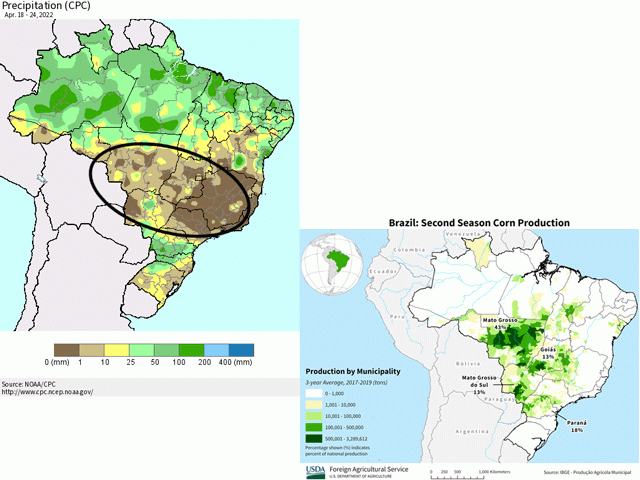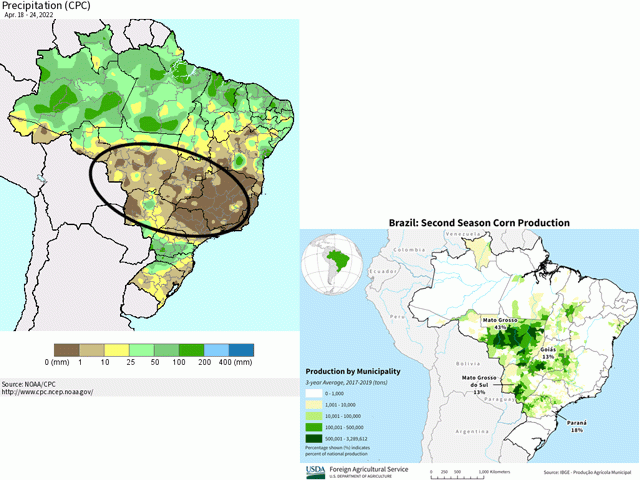South America Calling
Central Brazil Running Out of Soil Moisture Early
Central Brazil's distinct wet and dry seasons are quite impressive. With typically few exceptions, it rains every day in the wet season, and does not during the dry season. Usually, that winter transition happens rapidly around the first few days of May.
This year, the wet season trailed off rather quickly in mid-March and showers have essentially been absent since April 16, ending the wet season by more than two weeks.
Rainfall is needed at this point in the season to keep soil moisture topped off before the dry season starts and plants are forced to rely on available moisture to finish out plant development.
Producers in central Brazil usually want to plant by the end of February to put their corn plants in a good position to go through early development and pollination while the rains are still falling, leaving the crop to finish out its grain-fill period with the available soil moisture. When planting gets done on time and the rains end on time, this usually results in good corn production across the region. It is a high-risk, high-reward proposition for Brazilian farmers, however.
P[L1] D[0x0] M[300x250] OOP[F] ADUNIT[] T[]
The wet and dry seasons do not behave regularly. There is usually a lot of variability in both regarding the timing and intensity of showers. Some wet seasons are very wet and some are not. Sometimes the rains just shut off like turning off a spigot. Other times, the end is more gradual with showers waning in coverage and intensity for a month or more.
This season, the wet season started off very wet in central Brazil. It was enough to produce a good soybean crop. It did not live up to expectations, perhaps due to an overabundance of cloud cover reducing sunlight penetration, and perhaps due to increased diseases and pests. Both were touted by some analysts for the lower-than-expected yields.
But the availability of moisture for early in the safrinha (second-crop) corn season was exceptional. Much of the corn crop was planted ahead of schedule. An estimated 93% of the safrinha crop was planted in the ideal planting window before the end of February in Mato Grosso, Brazil's largest production state for safrinha corn, according to the Mato Grosso Institute of Agricultural Economics (IMEA). With showers increasing across southern Brazil also early on in the season, it is no wonder that many agencies, both public and private, increased their production forecasts for Brazilian corn.
However, there were signs that corn could be in trouble in central Brazil as early as mid-March. Showers started to wane more than is typically seen. And showers have been largely absent for the month of April. The weather service EarthDaily Agro was quoted in a recent article about Mato Grosso's weather that the state is likely to see its driest April in 17 years. Read more about that here: https://www.agriculture.com/….
The states of Goias and Minas Gerais have been right along with Mato Grosso in the dryness department. Both of those states have yet to reach 25 millimeters (roughly 1 inch) of precipitation anywhere in their primary safrinha corn growing areas. Together, the three states produce roughly 60% of Brazil's safrinha corn crop.
With the lack of rains in the last month, soil moisture has been on a steady and rapid decline. Satellite data was not recently updated as of this writing, but through April 14, soil moisture was roughly in the 30th percentile or lower throughout almost all three states.
With soil moisture declining before widespread pollination set in, it should come as no surprise if production estimates decline from here on out. Some of the crop made it to pollination with enough soil moisture to set up good yields, while others did not. It is hard to estimate just how much corn could be at risk for significant yield declines, but the situation is not going to get any better. It can only get worse.
The dry season is upon the region. The prospect for rainfall is dismal for the rest of the season. In the short-term, there is a frontal boundary that will move through central Brazil May 3-6 and will bring some showers. But those are likely to be spotty, brief, and light, if they occur at all. Other chances for rainfall are not anticipated by models at this time through early June.
To find more international weather conditions and your local forecast from DTN, head over to https://www.dtnpf.com/…
John Baranick can be reached at john.baranick@dtn.com
(c) Copyright 2022 DTN, LLC. All rights reserved.





Comments
To comment, please Log In or Join our Community .